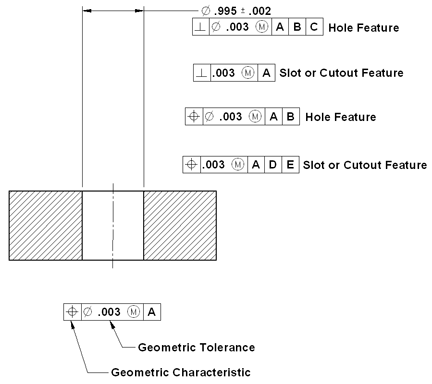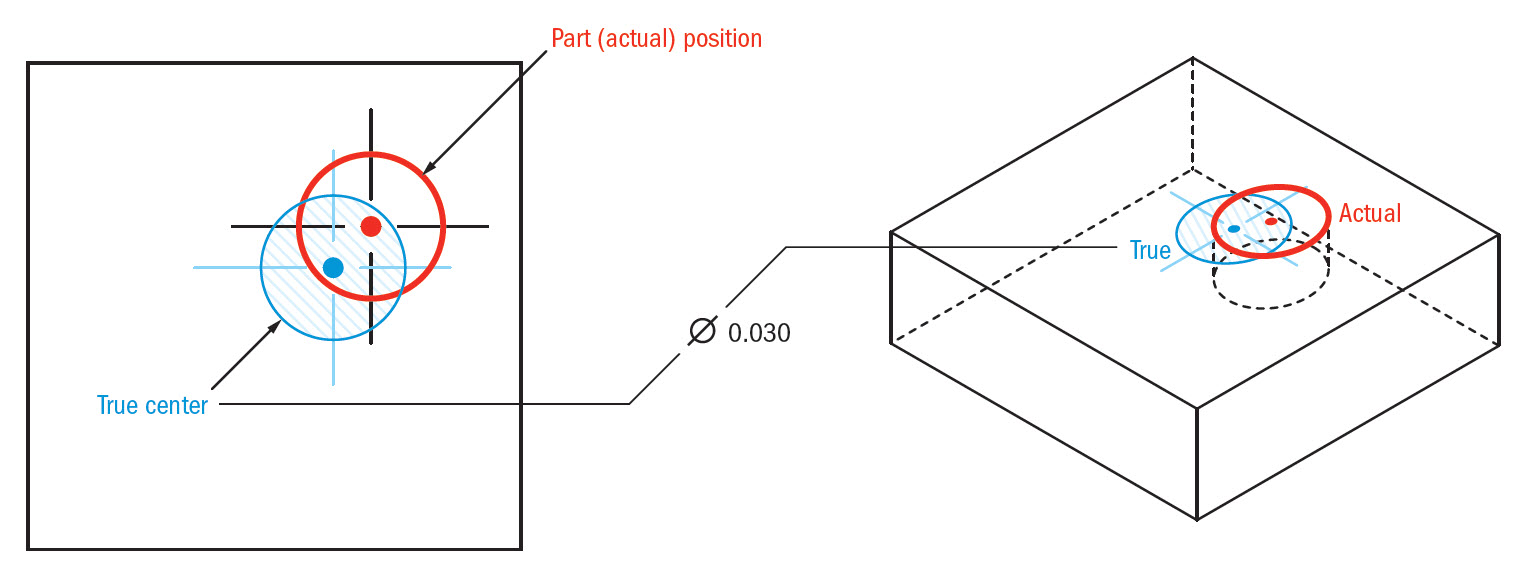Manual Calculation Of True Position Technologies
'Car 54, where are you?' This is a meaningless question. All positions are relative.

They are relative to something. And, calculate it from WHAT?I suggest that you go (back) to high school and pay attention in math and geometry classes.I am sure this thread will be closed.Edit: Well, I guess the term 'true position' has a specific meaning that I was not aware of. I apologize if my remarks above were not appropriate. But then, it seems to me that this is a poor choice of terms for what is actually meant.Last edited by EPAIII; at 02:17 PM.
True Technologies Inc
What is the formula for calculating true position?ThanksUsually when the print says put the hole here, I just put it there, thats how I 'calculate' it. The formula would be using a Cartesian coordinate system. (basic XY graph)REDIT: 'Cause your a newb, ask the right question you must young Padewan. There is no formula for it, it just is true or not true, try getting it there and if it doesn't work then post a question about that.
BUT here's an Olive branch, if you are asking how to measure TP, divide the tolerance for TP by 3 and use that for you linear tolerance between points and Origin/Datum and that will get you really close. Thank you for the input guys, I am sorry if my question offended anyone but I am a newb and it sometimes comes with the territory. I think people forget that at some point in time you did not know everything but you had to learn and perhaps relearn something's you haven't brushed up on in 10+ yrs.I guess my question pertains to a hole location for example it's nominal is x30. Y30 within.2 true position, But it measures x30.011 and y 30.011.
I want a way to fact check our older brown and sharp cmm. How would I calculate true position based on the given example. As mentioned, true position is the circular tolerance zone around a theoretically perfect point, in your case.100 or R.05.If you inscribe a square, the corner at 45 deg will be your radius (.05)Remember the 45 deg right triangle relationship, 1/1/SQRT2?The quick and dirty way we used to calculate it was:True position tol.(in radius) / SQRT2In your case:.05/SQRT2 =.0354So basically, if your measured results are within +/-.0354, you are within that box and within your true position tolerance.If your measured results are outside that box, you will have to trig it out like johnb53405 said. Better than calculating is to find the survey marker and use a certified chain and then measure. Yes some survey numbers are in Rods. So look that up.Actually true position is most often a certain distance from a certain place so place + or - distance = position is the correct formula.To confirm look it up in a book.If you cant find a book to confirm then write one and it will be a big help to everyone who can't find position,A Rod is about 5.0292 meters and/or about 16.5 feet and/or 5.5 yards.They made it not an even number so the Metric/ imperial guys would not consistently argue about it.The Rod was based on how far a Martian could throw his wife.
Yes a grouchy wife would throw her husband so the number was not actual be an assumed average.Enough of this as I am going to Clair Mi, Camp Rotary for a week with the Boy Scouts.Yes we will use fishing rods.Yet another kind of Rod.And, Yes we sleep in those old army tents spiders and all, and a raccoon if you have any food in the tent. Thankfully not yet a Bear.Last year I got skunked and did not get top fish here. Inspired by this thread, I did some searching on 'true position'. Here's one:According to this, 'true position' is the theoretical position of the feature and then there is an allowable deviation from that 'true position' which is specified as the diameter of a circle enclosing the permissible locations.
I suspect you want a way for calculating that deviation from the 'true position'. That formula is given on that page.Wouldn't that be what we previously called a tolerance but refined into a circle instead of a square? Or am I still missing something here? Wouldn't that be what we previously called a tolerance but refined into a circle instead of a square? Or am I still missing something here?The part you are missing is that GD&T allows you to describe a FUNCTIONAL part.Plus or Minus tolerances on each axis make the manufacturing easy, but theydon't describe what is and is not functional.Take the 'True Position' thing. And most times, at least for me, you will see itwith a little M in a circle, Max Material Condition.That hole has to line up with or be within a certain distance of something else, eitheron the same part, or on another part.

Lets say a clearance hole for a bolt.1/4' bolt,.275 ±.010 clearance hole. Tolerance on the other bit lets say is.005 TP.IF the engineer is willing to skirt the edges we would see.275 ±.01 TP within.010, andthen we would get the Magical 'Max Material Condition'.So a.265 hole could be.010 off TP. If its.005 off in the Y, it'll still work if its.0000 off in the X.
If we had to describe this with simple ± XY tolerances, we would have tobe ±.0035, and the part would still be FUNCTIONAL, but would be scrap per the print.Now lets say we drill that hole to nominal,.275. MaxMaterialCondition(MMC), we get a.010 BONUS.We can be off.010 now in the Y, and ZERO in the X and still have a functional part. We canalso be.006 off in the Y and.007 in the X and still have functional part. Much better thanthe ±.0035 if we went with simple plus/minus tolerances.Now lets take that hole to.285, we get yet another.010 of bonus on the TP. And we can be evenfurther off.Its pretty darn cool stuff when you made the parts and then do the assembly and can actuallysee the GD&T in action. And a lot of times it actually benefits the machinist, its justmore complicated.I personally prefer it.
It makes the prints look scary, and the 'value' of the part goes up, meaningI get more money. When in reality its actually easier to deal with than straight ± tolerances (mostly). This has always seemed to me to be 'what happens' when I send out a dwg that has a goodly dose of GD&T feature control frames. I think most shops see all that geo tolerance stuff (even if it's dead simple and easy) and fill in a multiplier factor on the quote prep sheet. Sort of like when you buy something whose description includes the words 'clean-room compatible'. Makes the price go up 5X.I agree, but there is a reality in the added cost, even when it is dead simple.
IE; I interpret one thing as dead simple, Hole to Hole TP easy!! Now my part goes to Quality, my inspector feels that all GD&T needs to be done on the CMM (ya ya I know, but it's his department) ANY time a part needs to be checked that way, it takes longer. Now shop rate is not the same for QC as it is for Manufacturing BUT it's still there.
And thats just one linear dimension/2 holes.R.
Hello,I have added two data analysis work sheets with multiple formulas to my work book. The calculation of these formulas is slowing down the whole work book.I guess every time I make a change somewhere it updates the results.I tried to change calculation to manual but that affects the whole work book.:x I want only the two data analysis sheets to work on manual calculation.Others should work as they did before I added those analysis sheets.I guess we need some kind of macro for this problem?
Well,Thanks for the tip Ahnold! I haven't tried it yet, but I guess your solution works so that it updates a certain work sheet when it's being opened? I will definetely try it if no better solutions come up.But sometimes I select the wrong work sheets, and I wouldn't like to wait for the calculations to be done in that case.
True Position Technologies Valencia
I would appreciate if anyone could come up with a solution where you could really turn certain work sheets (for example 'sheet2' and 'sheet3') to manual calculation.You see, I was thinking about adding an update button on those analysis sheets of mine. Hello,I have added two data analysis work sheets with multiple formulas to my work book. The calculation of these formulas is slowing down the whole work book.I guess every time I make a change somewhere it updates the results.I tried to change calculation to manual but that affects the whole work book.:x I want only the two data analysis sheets to work on manual calculation.Others should work as they did before I added those analysis sheets.I guess we need some kind of macro for this problem? Tushar is correct that it is generally not a good idea to use sheet.calculate unless you are extremely careful about intersheet dependencies (because sheet.calculate ignores them so you may get incorrect results).It is also possible to switch sheets off from automatic calculation using worksheet.enablecalculation, (This is what FastExcel uses internally for mixed-mode calculation) but you need to be careful about how you do this (the property is not saved with the workbook, it triggers a full sheet recalc and there are potential dependency problems).
(30 responses) i copied numbers from an online account. Pasted them into excel 2002.
How do i convert the numbers to numbers i can multiply etc? I tried pu.(10 responses) I have a spreadsheet with data from a survey: 9 questions, each with an answer between 1 and 5. I have a pivot table that shows me a breakdo.(16 responses) I have a ComboBox that I am trying to get the BackColor to change based on a selection.
There are 11 ComboBoxes on the sheet. After I have g.(11 responses) I am trying to save excel worksheet to PDF however encountering runtime error 1004 with the msg with reads as 'Document not saved. The.(8 responses) I need to convert a number, which will be of indeterminate length, into a text string of fixed length. The length is 14 characters long. To f.The Holy Grail of Excel Tips $12.60.
